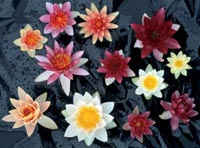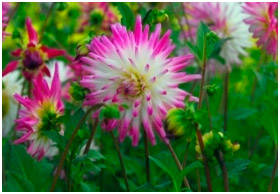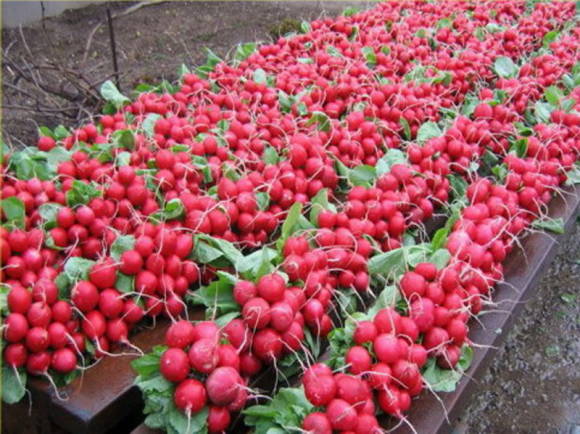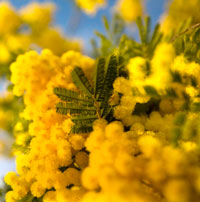Anguria can be safely attributed to exotic plants, but this does not mean that it is not known and cultivated, in fact, it is found in culture not only in Russia and Ukraine, but also in Western countries, where it is eagerly eaten.
Anguria fruits have thorns, look frightening, however, the taste is pleasant, and even the medicinal characteristics are considerable. In our country, this plant is also called the Antilles cucumber, a little less often - horned cucumber.
Despite the wonderful appearance and strange names, anguria can be grown quite easily on your six hundred square meters.
About culture in detail
Of course, the most famous and widespread anguria in its homeland, that is, in Central and South America. Since ancient times, anguria was widely spread with the help of birds, they loved the contents of the fruit and swallowed the pulp along with the seeds, then scattered at various distances, and the seeds, passing through the gastrointestinal tract and leaving naturally, fell to the ground. And if they got into favorable conditions, they germinated. This is how real thickets of anguria were often formed, which sometimes appeared in the most unpredictable places. In such a simple way Anguria reached the Indian and Far Eastern tropics. But anguria is cultivated not only there, it is successfully grown in temperate climatic latitudes, where it performs a double function, being an ornamental and cultivated plant, that is, its fruits are actively used for food, and plants decorate the site.
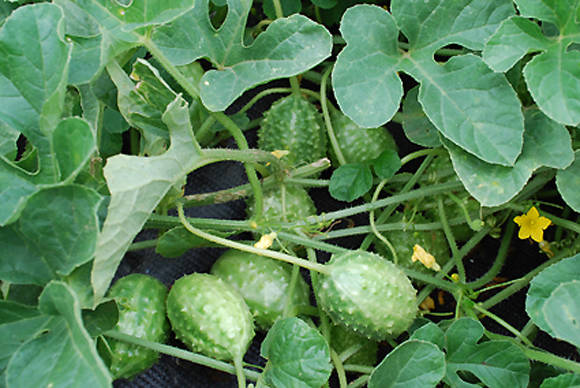
Biologically anguria(Cucumis anguria) - this is a liana belonging to the family of pumpkin, familiar to all of us, it has climbing stems, a large number of antennae, with the help of which the stems are securely attached to any support, as well as curly foliage, which is similar to that of a watermelon, and yellow flowers. Anguria's stems reach a height of 3 m and are distinguished by dense pubescence.
The fruits are cylindrical in shape, they are not very large, usually reach 50 g and stretch about 10 cm (more often less, less often - more).
The peel of the fruit is prickly, elastic to the touch, and has a green color. Ripe fruits change color from green to yellowish-orange. The pulp of the fruit is covered with rather large seeds.
It is interesting that the most valuable fruits are those that are not harvested in full maturity, but when they are not yet ripe. Usually, fruits at this degree of maturity can be harvested 70 days after the emergence of seedlings obtained from sowing seeds.
If you delay the collection of fruits, then their pulp will become unpleasantly sweet and, one might say, unsuitable for food, but unripe fruits are much more pleasant to the taste. In addition to fresh consumption, anguria fruits are successfully salted and pickled, cutting off the thorns beforehand.
Since 2013, the Anguria variety has been listed in the State Register of Breeding Achievements of the Russian Federation
Dietary - for growing in all regions under temporary film shelters. Recommended for use in fresh young fruits (technical ripeness) and for canning. The period from emergence to the first harvest of fruits is 48-50 days. Bee-pollinated. The plant is climbing, characterized by strong growth and high shoot-forming ability. Stems are thin, fragile, pubescent with antennae. Leaves are dissected, light green or green. Fruits in technical ripeness are oval, light green in color with longitudinal white stripes, pubescent with white spines, 5.3-6.5 cm long, weighing 43-46 g (up to 50 g). The pulp of the fruit is greenish-yellow, juicy, of medium density with a cucumber aroma. The taste is sour, good. The plant produces 45-50 fruits. The yield of marketable fruits in technical ripeness is 7.15-8.24 kg / sq.m. The fruits retain their commercial qualities for 7-10 days.

The subtleties of biology
If we talk about anguria from a biological point of view, first of all, it should be noted the very active growth of this plant and a consistently high yield.In just 60 days, a vine can bloom and give a full harvest, and if the plant is properly looked after, then 200 pieces of fruits can be easily collected from one specimen.
History
The Indians were one of the first on the planet to actively cultivate Anguria, it was they who brought the agricultural technology of growing this crop in their climate to almost perfection and always received high yields.
Present time
Now very large plantations of anguria, established for the purpose of obtaining fruits, can be found in the UK, USA and New Zealand.
Interestingly, in the southern regions, the first fruits can be harvested already in the middle of summer and continue to be harvested until the first frost, which comes very late in such regions. In the center of Russia, fruits are usually harvested from August to mid-November. In cooler regions, collection is usually limited to September.
Anguria requirements
Anguria requires a lot of heat, sufficient nutrition in the soil and a moderate amount of moisture. The optimum temperature for the growth and development of this culture is in the range from +20 to + 27 ° C. At elevated temperatures, the plants can be watered more actively, but if the temperature suddenly drops sharply, say, to + 10 ° C, then the liana will seem to freeze, stop growing and developing, and at lower temperatures it may even die.
The subtleties of Anguria agricultural technology
The very agricultural technology of growing anguria is very similar to that of other pumpkin crops. Angurias need plenty of light, light soil with neutral acidity, appropriate previous crops and proper care. When choosing a place for anguria, try to choose the most well-lit area - the plant will grow very poorly in the shade, even in a rare shade.
To protect anguria from wind and draft, crops such as corn or sunflowers can be planted on the north side.
The ideal option is to place anguria on a site that has a slight elevation, where melt, rain, irrigation water does not accumulate and bypasses cold air.

Planting anguria seedlings
In the south, anguria can be grown by simply sowing seeds in the ground, in colder regions it is more appropriate to grow it through seedlings. Sowing seeds should be done in boxes with nutrient soil around the beginning of April. In order not to transplant anguria, it is best to sow seeds in separate peat-humus cups and put the latter in boxes, because anguria reacts extremely painfully to root injuries, and they are almost inevitable when picking or replanting seedlings to a permanent place.
The seeds are buried in the nutrient soil by about 1 cm, having made a hole in advance and pouring out half a glass of water. After sowing, the seed is sprinkled with fresh soil, and a plastic cup is placed above the peat-humus cup, thus, getting something like a greenhouse. Usually, it takes a week for seedlings to appear, the temperature in the room is about + 22 ° C and moderate humidity.
You need to put boxes with seedlings on the southern windowsill, there should be enough light, but if the day is cloudy, then you will have to turn on the additional lighting lamps, otherwise the seedlings may stretch out.
After the seedlings have formed several pairs of true leaves, when the weather is stable and the temperature is consistently above + 10 ° C, the seedlings can be transplanted into open ground.
On the site, you first need to select a place where legumes, root crops, cabbage or green crops previously grew, that is, the best predecessors for anguria. Next, you should dig up the soil on a full bayonet of a shovel with a rotation of the layer, be sure to remove all the remnants of weeds, loosen the soil and make holes in the size of peat-humus cups.
Add 2 teaspoons of wood ash to the base of each hole, after spilling them with a pink solution of potassium permanganate. If there is no wood ash, then you can put a handful of humus.
Make a hole from the hole with an indent of 50 cm, not forgetting that this is a fast-growing vine.
As for the support, you can put it right away, or it can be a week after planting the seedlings, by that time the plants can stretch by about 20 cm, and there will be a need for support.
The liana clings to the support with a mustache, they can be attached on their own, thus, directing the whips along the desired path of development.
Further care of anguria
It is imperative to provide for watering, fertilization, prevention and treatment of diseases.
Watering. You should know that anguria does not tolerate excess moisture, so moderate watering should be done and done when it is hot. If it has rained, then on this day anguria cannot be watered, and the next day it is already possible, guided by the degree of soil moisture. If it is hot and there is no rain, then you can water the plant every night, pouring a couple of liters of water under each plant at the initial stage - in the first month, and then doubling the amount of water poured out.
Do not forget that you cannot water the anguria with ice water from a hose; you should use water at room temperature and, ideally, if it is rainwater.
Fertilization. Anguria loves foliar dressing, that is, spraying with a fertilizer solution directly on the foliage. The best option is to dilute nitroammophoska in the amount of 2 teaspoons per bucket of water and spray the plants with this solution, wetting the entire above-ground mass. During the flowering period, such spraying should not be done, but at the end of it, it is quite appropriate.
If we talk about standard soil fertilization, then it is also necessary, and you can alternate the application of mineral fertilizers and organic matter. At the very beginning of plant development, it is best to use an infusion of mullein diluted 10 times, but nitroammophoska will be a mineral fertilizer - this is ideal. Fertilizers can be applied every month, twice, for example, at the beginning of the month and in the middle - infusion of mullein, 500 g per plant, and nitroammofoska - half a teaspoon per plant, in pre-watered and loosened soil.
There are also tricks for growing anguria. For example, if you want the fruits to develop as quickly as possible, then just pinch the top of the central vine.
Diseases. It is extremely rare on Anguria plants to see rot, powdery mildew or anthracnose. The first step is to remove all damaged parts. If this does not work, and the plant continues to hurt, then you will have to treat it with a fungicide permitted in this season, strictly following the instructions on the package.
In case of late use of fungicides, strictly follow the instructions on the package, there must be a period of complete disintegration of the substance, after which the fruits can be eaten. For example, it will be written - no later than 20 days before harvesting, which means that even if there are 19 days left before harvesting, it is no longer recommended to use a fungicide.
Pests. It can be aphids or ticks, insecticides should be used against aphids, acaricides against ticks, also following the instructions.
Anguria yield
In the southern regions, a hundred or even more fruits can be harvested from each plant. The farther north, the shorter the fruiting period due to the faster onset of cold weather, therefore, the number of fruits also decreases. It is best to pick the fruits in the morning, when they are full of moisture, dense, juicy.

Useful properties of anguria
The chemical composition of Anguria fruits is very rich and has a purely positive effect on the human body, so they can be safely eaten fresh or prepared.
100 g of raw product contains few carbohydrates, a mass of useful minerals: for a carbohydrate - 2.7 g; b trees - 1.4 g; n search fibers - 2.2 g; in itamine C - 9.6 mg; in itamine B1 - 0.1 mg; to aliy - 327.7 mg; to altium - 20.9 mg; n atrium - 11.0 mg; phosphorus - 25 mg; m agnium - 9.6 mg; c inc - 0.2 mg. Energy value - 13.8 kcal.
Anguria seeds are also edible. They contain a lot of oil with a pleasant nutty flavor. However, they are not easily freed from the surrounding fibrous tissue.It is believed that gruel made from flour obtained from dried and ground seeds, diluted with water, expels tapeworms from the body. However, usually anguria for food consumption is removed before the seeds ripen, no later than 60 days after sowing.
It is reliably known that the consumption of anguria promotes faster wound healing, has a tonic effect, has a beneficial effect on the cardiovascular system and the digestive system, lowers the level of bad cholesterol in the blood, and relieves the symptoms of hemorrhoids. It treats the prostate gland and kidney inflammation, fights nausea and feeling unwell. Eating anguria, it is impossible to gain excess weight.



